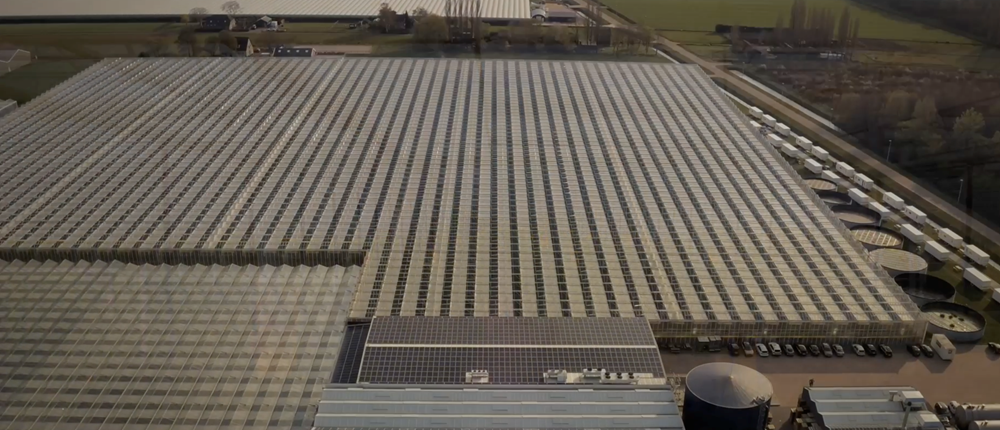Pure quality. That is undeniably the best way to describe Royal Berry strawberries based in Bemmel, The Netherlands. However, nowadays offering a high-quality top product is no longer enough to fully meet the customer's expectations. Director Jan van Genderen explains why he believes sustainability is an opportunity to set his company apart. ‘It is about so much more than just growing a great product.’
Royal Berry's acreage has now grown to 48 hectares. One half is under glass, the other 24 hectares are outdoors. At the age of seventeen, Jan started growing strawberries with a 4000 square metre greenhouse, which was more than four times the size of his father’s. By thinking big, Royal Berry became what it is today: a leading strawberry grower that exports globally, from Germany all the way to Japan.
A foundation built on customer satisfaction
And thinking big is essential when considering the growing demand for sustainable products. Jan explains the rise of sustainable products: ‘We are 100% driven by what the consumer wants. After all, the consumer determines the demand at the supermarkets, and they are our largest customers. In other words: through the supermarkets, consumer behavior directly affects our company. There is way more demand for sustainable products now than there was ten years ago. The difference from just three years ago is already massive in that respect.’
This call for sustainable products requires innovation and adaptability. And the strawberry giant is happy to embrace these developments. ‘Of course, it is not always easy, but that is precisely why it is an opportunity to really set ourselves apart. After all, if it was easy, everyone would do it. But if you ensure that you can meet the demand for sustainably grown products, you can strengthen the bond with your customers,’ Jan enthuses. ‘It makes it much harder for customers to find an alternative.’

More than just carbon emissions
A surprising example pops up when discussing staff policy. ‘In times of staff shortages, it is literally impossible to run a company well while ignoring the long term. That is why, above all, we try to ensure that people feel at home with us,’ says Jan, emphasising the importance of being a good employer. The number of employees at Royal Berry varies from 30 to around 350 people. ‘We manage the entire process from registration to payment in-house. That includes everyone's insurance. Everything must be properly organised. We have to take care of the entire chain; sustainability goes so much further than just carbon emissions.’
These carbon emissions are inextricably linked to creating a particular climate, which is the core business of a horticultural company. ‘This is a challenge, of course, and that's exactly what requires a professional approach. We try to create the best possible climate while consuming as little energy as possible,’ Jan elaborates enthusiastically, explaining various sustainable applications. ‘We have invested heavily in solar energy. All commercial buildings that do not have plants in them are covered with solar panels. Outside we also have an unused plot full of panels. All in all, it’s an area of around one hectare. This makes it possible to generate more energy than we consume from March to September,’ Jan clarifies.
In addition, the lighting consists of dimmable LEDs and a screen system is used to regulate sunlight. ‘In 2017, we became the first to start using Svensson's Luxous 1147 FR fabric. This screen closes if too much light comes in from the outside, but still lets sufficient light through. In terms of energy, there are real, direct gains. You really notice that you have to pump less heat into the greenhouses; you need 47% less energy. And that has a lot of impact. Immediately,’ Jan says, explaining the choice of these applications.
One of the sites, Salvia, has both greenhouse cultivation (6.5 ha.) and outdoor cultivation (7 ha.). Jan explains that this as another example of a sustainable solution: ‘This particular site is one hundred percent energy neutral because it has been connected to a biomass power station. Everything allows our company to take small steps in sustainability every time. Of course, you can’t become energy neutral in one fell swoop.’
Take the CHP , for example, which is still required, especially during the winter months. ‘Of course solar and wind energy are great, but they are not always available. In my view, the CHP is still a super-efficient and relatively clean alternative when there's no sun or wind. Thanks to the CHP, you’re still flexible. This flexibility is essential, but the surcharge on the electricity rates does pose a problem in this respect,’ Jan says, succinctly summing up the current problems on the energy market.
What the future holds
Does that cause any concerns for the future? ‘No, I am very positive about the future of sustainability,’ Jan concludes cheerfully. ‘The Netherlands is a beautiful country with a lot of innovative power and an entrepreneurial spirit. The right stakeholders must enter into a dialogue with each other and work together. Currently, businesses tend to get surprised by government policy, and the other way around. But we live in a country where a lot of things go well, and we have to build on that. This will allow us to make real sustainability gains and make the world so much nicer as a result.’